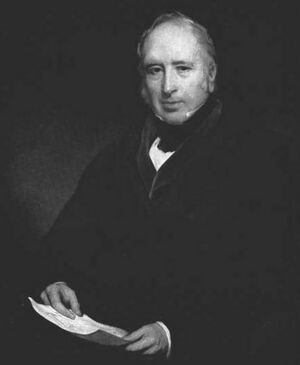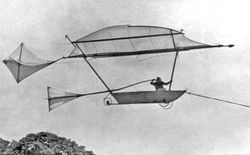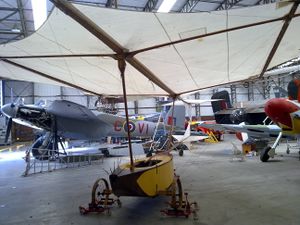جورج كايلي
جورج كايلي Sir George Cayley | |
|---|---|
 جورج كايلاي | |
| وُلِدَ | 27 ديسمبر 1773 |
| توفي | 15 ديسمبر 1857 (aged 83) برومپتون سوركشاير،، إنگلترة |
| الجنسية | British |
| اللقب | صمم أول طائرة شراعية ناجحة. اككتشف aerodynamic forces of flight weight, lift, drag, thrust and cambered wings, basis for the design of the modern aeroplane. |
| السيرة العلمية | |
| المجالات | طيران، ديناميكا هوائية, Aeronautics, Aeronautical engineering |
السير جورج كايلي Sir George Cayley[1] البارون السادس (و. 27 ديسمبر 1773 – ت. 15 ديسمبر 1857)[2] كان مهندسا إنجليزياً ومخترع وطيار. من أهم الشخصيات في تاريخ الملاحة الجوية. Many consider him to be the first true scientific aerial investigator and the first person to understand the underlying principles and forces of flight and the first man to create the wire wheel.[3]
In 1799, he set forth the concept of the modern aeroplane as a fixed-wing flying machine with separate systems for lift, propulsion, and control.[4][5] He was a pioneer of aeronautical engineering and is sometimes referred to as "the father of aviation."[3] He identified the four forces which act on a heavier-than-air flying vehicle: weight, lift, drag and thrust.[6] Modern aeroplane design is based on those discoveries and on the importance of cambered wings, also proposed by Cayley.[7] He constructed the first flying model aeroplane and also diagrammed the elements of vertical flight.[8] He also designed the first glider reliably reported to carry a human aloft. He correctly predicted that sustained flight would not occur until a lightweight engine was developed to provide adequate thrust and lift.[9] The Wright brothers acknowledged his importance to the development of aviation.[9]
Cayley represented the Whig party as Member of Parliament for Scarborough from 1832 to 1835, and in 1838, helped found the UK's first Polytechnic Institute, the Royal Polytechnic Institution (now University of Westminster) and served as its chairman for many years. He was elected as a Vice-President of the Yorkshire Philosophical Society in 1824.[10] He was a founding member of the British Association for the Advancement of Science and was a distant cousin of the mathematician Arthur Cayley.
سيرته
ولد في مدينة برمبتون هال في مقاطعة يوركشير بعد أنهى اختصاصه في البوليتيكنيك من اكتشافه اخترع آلة صقالة عام 1809 وهي تعتبر أول محاولة للطيران بواسطة محرك ثم اضاف غليها بعد ذلك محرك بخاري لكن وزنها أصبح ثقيلا .
وكان كايلي الذي ولد عام 1773م في العاشرة من عمره عندما شاهد طيران البالونات الأولى التي أدهشت العالم بأسره، ولقد ألهبت هذه البالونات التي كانت تستخدم الغازات حماسه ودفعته للتفكير في إمكانيات الطيران، ولكنه اتخذ قراراً مبكراً بأن يستخدم سطحاً مائلاً يدفعه محرك أولي خفيف بدلاً من الانشغال بأمر المركبات الأخف من الهواء
كما حقق أول طيران بمروحية وذلك عام 1796.
غطت اهتماماته نطاقاً واسعاً من الأمور، فلقد بحث خلال عمره الذي بلغ 84 عاماً موضوعات متناثرة، مثل الصرف، واستصلاح الأراضي، ومحركات الهواء الساخن، والجرارات الزراعية ذات الجنزير، والأطراف البشرية الصناعية، وكان بالإضافة إلى ذلك أحد الفلاسفة الطبيعيين وداعية لنشر التعليم وعضواً في البرلمان وأحد الأعضاء المؤسسين للاتحاد البريطاني لتقدم العلم.
ولقد وصف المؤرخون كايلي بأنه المخترع الحقيقي للطائرة، وقد تكون في هذا اللقب مبالغة، إلا أن الأمر الذي لا شك فيه هو أن كايلي وضع أساس بحوث الطيران التي جاءت بعده، فكان أول من جمع شتات العناصر العديدة اللازمة للطيران العملي في كيان نظري موحد، ولم يفكر في الجناح على أنه وسيلة لإحداث الرفع فقط، بل اهتم أيضاً بالمقاومة التي يحدثها جسم يتحرك خلال الهواء، وبحث أمر مساحة السطح الرافع اللازم لحمل وزن معلوم في الطيور، وأدرك أن خواص الرفع تختلف في الأجنحة بتغير الزاوية التي يتحرك بها الجناح في كتلة الهواء المحيطة به، واقترح نظاماً ميكانيكياً للقدرة هو عبارة عن محرك أطلق عليه اسم (المحرك الأول)، وأدرك أنه من الضروري أن يكون خفيف الوزن، واقترح أن يعمل بوساطة الاشتعال المفاجئ لمساحيق أو مواد قابلة للاشتعال، وهي الطريقة التي يعمل بها محرك الاحتراق الداخلي، وأدرك أيضاً ضرورة تزويد للطائرة بصفتي الثبات والتحكم.
وأوجز كايلي المهام التي تواجه علماء الديناميكا الهوائية في عبارة بالغة الإيجاز والوضوح قائلاً: (إن المسألة برمتها تقع داخل الحدود، جعل سطح يحمل وزناً معلوماً عن طريق استخدام القدرة للتغلب على مقاومة الهواء).
الماكينات الطائرة
انظر أيضاً
المصادر
- ^ "George Cayley's life". hotairengines.org.
- ^ Bagley, John A. "Cayley, Sir George, sixth baronet". قاموس أكسفورد للسيَر الوطنية (online ed.). Oxford University Press. doi:10.1093/ref:odnb/37271. (Subscription or UK public library membership مطلوبة.)
- ^ أ ب
- "Sir George Cayley". Flyingmachines.org. Retrieved 26 July 2009.
- "The Pioneers: Aviation and Airmodelling". Retrieved 26 July 2009.
- "U.S Centennial of Flight Commission – Sir George Cayley". Archived from the original on 20 September 2008. Retrieved 10 September 2008.
- ^ "Aviation History". Retrieved 26 July 2009.
- ^ "Sir George Cayley (British Inventor and Scientist)". Britannica. Retrieved 26 July 2009.
- ^ Sir George Cayley – Making Aviation Practical U.S. Centennial of Flight Commission. Retrieved 28 June 2016
- ^ C. H. Gibbs-Smith (20 September 1962) New Light on Cayley Flight International, link from Flightglobal
- ^ "Sir George Cayley". U.S Centennial of Flight Commission. Retrieved 10 September 2008.
- ^ أ ب "The Pioneers: Aviation and Airmodelling". Retrieved 26 July 2009.
- ^ Annual Report of the Yorkshire Philosophical Society for 1824. Yorkshire Philosophical Society. 1825. p. 34. Archived from the original. You must specify the date the archive was made using the
|archivedate=parameter. https://www.biodiversitylibrary.org/item/250327#page/48/mode/1up.
وصلات خارجية
- Hansard 1803–2005: contributions in Parliament by Sir George Cayley
- 2007 Biography of Sir George Cayley
- Cayley's principles of flight, models and gliders
- Cayley's gliders
- Some pioneers of air engine design
- Sir George Cayley – Making Aviation Practical
- Sir George Cayley
- Gibbs-Smith, Charles H. Sir George Cayley: 'Father of Aerial Navigation' (1773–1857) Notes and Records of the Royal Society of London, Vol. 17, No. 1 (May, 1962), pp. 36–56
- Ackroyd, J.A.D. "Sir George Cayley, the father of Aeronautics". Notes and Records of the Royal Society of London 56 (2002) Part 1 (2), pp167–181, Part 2 (3), pp333–348
| پرلمان المملكة المتحدة | ||
|---|---|---|
| سبقه Charles Manners-Sutton Edmund Phipps |
عضو برلمان عن سكاربورگ 1832–1835 مع: Sir John Vanden-Bempde-Johnstone, Bt |
تبعه Sir John Vanden-Bempde-Johnstone, Bt Sir Frederick Trench |
| بارونية إنگلترة | ||
| سبقه توماس كايلاي |
بارون (برومپتون) 1792–1857 |
تبعه Digby Cayley |
- Wikipedia articles incorporating a citation from the ODNB
- Pages using cite ODNB with id parameter
- Short description is different from Wikidata
- Pages using infobox scientist with unknown parameters
- Persondata templates without short description parameter
- مخترعو طيران
- رواد الطيران
- إنجليز من القرن 18
- إنجليز من القرن 19
- طيارون إنجليز
- مخترعون إنگليز
- مهندسو طيران
- علماء ديناميكا هوائية
- تاريخ الطيران
- الطيران في المملكة المتحدة
- أعضاء برلمان المملكة المتحدة عن دوائر إنگليزية
- Whig (British political party) MPs
- Baronets in the Baronetage of England
- Kites
- مواليد 1773
- وفيات 1857
- أعضاء برلمان المملكة المتحدة 1832–1835
- People from Brompton-by-Sawdon



